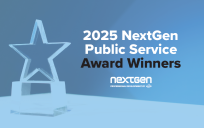Trump’s fiscal 2021 budget suggests emerging technology ranks among the federal government’s top priorities. Consequently, agencies are feeling more pressure than ever to adopt tools such as artificial intelligence (AI).
Digital transformation doesn’t happen overnight, however. At most agencies, integrating emerging technologies takes significant energy, money and time. Furthermore, the impact of emerging technologies extends beyond innovation and modernization. Any new technology, whatever benefits it brings, will also introduce new vulnerabilities that must be addressed. That double-edged sword can hinder the speed of adoption.
“It’s about the accelerated pace of emerging technology,” said Dean Pianta, Cloud Director at SAP National Security Services (NS2). “With any emerging technology, there’s enormous potential. But there’s a lag before we can put it to use.”
Unfortunately, technology environments that constantly change can create multiple risks for agencies. For starters, every shift in technology opens fresh security vulnerabilities that weren’t there before.
“It’s easy to take advantage of cheaper, quicker infrastructure that isn’t as locked down,” Pianta said. “There’s so much coming out that we as humans can’t consume all of it.”
Cost overruns are another risk for agencies. As their technology environments evolve, many agencies are surprised by the spending it takes to keep up.
“These are the things that you figure out as you stub your toe,” Pianta said. “But you don’t figure that out on Day One.”
Finally, agencies are notorious for being risk-averse, and their technology environments may lack a key factor for success: Agility. In turn, these agencies won’t be able to react to the fluid demands of their citizens and missions.
Currently, agencies are navigating the COVID-19 pandemic. Within days of starting, the viral outbreak has forced agencies to operate in ways they had not prepared for. Presently, which agencies can handle the bandwidth requirements for their entire workforce to telework? Which agencies have the tools to collaborate, gain insight and shape outcomes in real time? Saying “no” to emerging technology could reduce risks and costs the most during this period but standing still is not an option. Agencies need a comprehensive innovation strategy for keeping up with a world that never slows down.
The Solution: Comprehensive Innovation With Cloud
Cloud is crucial for a comprehensive innovation strategy for several reasons.
First, cloud’s agility means it can quickly support emerging technology. Whether it’s about rapidly setting up development environments to “fail fast,” or immediately reacting to surging computing demand, cloud enables speed and scalability.
Second, cloud can store, manage and scale vast amounts of data worldwide. This capability can anchor future analytical and AI services. When agencies use data to shape policies, practices and operations, they typically utilize data stored in the cloud.
Third, cloud’s service orientation and adherence to open standards allows agencies to rethink the entire technology stack. Moving from cloud to cloud or supporting high-availability, multicloud strategies in days, not weeks, is all possible. Here the cloud offers a continuous, secure path of innovation for commercial industry to bring their technology to the federal government.
“If done properly, you can add new features and drive business value with the click of a button,” Pianta said. “This is where commercial innovation supporting millions of users around the world can make its way efficiently, effectively and securely to the ‘tip of the spear.’”
This article is an excerpt from GovLoop’s recent report, “A Comprehensive Strategy for Driving Innovation.” Download the full report here.






Leave a Reply
You must be logged in to post a comment.